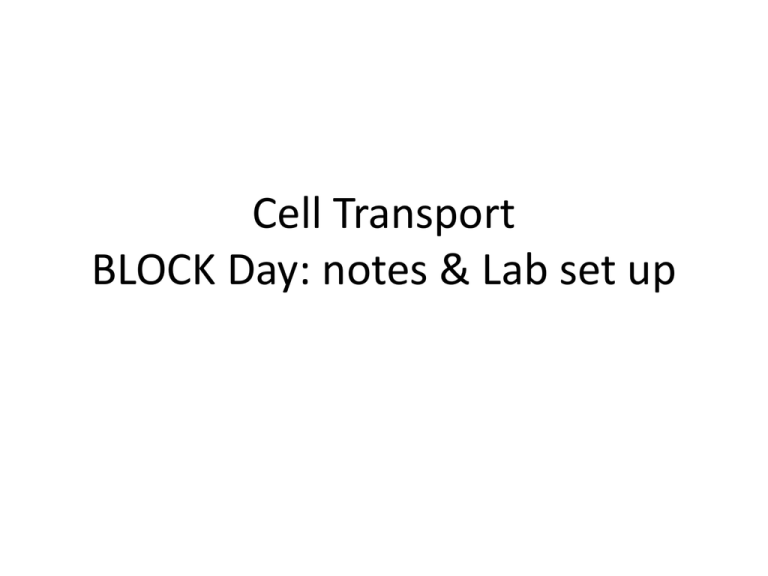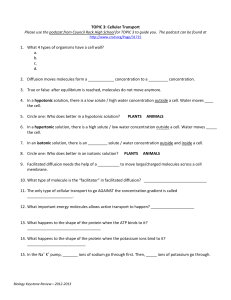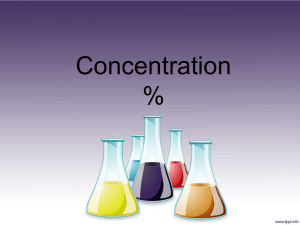Cell Transport notes and lab
advertisement

Cell Transport BLOCK Day: notes & Lab set up Bellwork 1. What is concentration? (NOT the kind where you’re thinking really hard…) 2. Why is the orange juice you mix with water called “concentrate”? 3. Draw a picture showing the difference between the molecules in a LOW concentration solution vs a HIGH concentration solution 4. What is the difference between being passive and being active? Cell Membrane Notes (in notebook) • Copy down only most important things from each slide. ON ODD PAGES INFO 3 drawings/diagrams 3? 1 memory strategy summary 2 On Slates: name that membrane part (1-5) phospholipid 5 3 1 4 MYON – Diffusion & Osmosis • • • • • • Semi-permeable Solute Solvent Solution Simple Diffusion Concentration Gradient • Osmosis • Golden Rule of Osmosis Hypotonic Isotonic Hypertonic Being Semi-permeable Selective Permeability Certain molecules can pass through and others are prevented. Which part of the cell is semipermeable? Look around the room, can you name some things that are permeable and not permeable? Why is permeability important? Small molecules, such as O2 & CO2, can enter and leave the cell freely. Large molecules such as proteins and carbs can’t. Several processes are involved in moving materials across the membrane. THINK: Which is passive and which is ‘active’? What do these key terms mean? • SOLUTION • Solute • Solvent Solution • What are examples of each? Solute Solvent Concentration • Concentration: How close together molecules are in a solution; the amount of solute in a particular amount of solvent • Which beaker has a higher concentration of food coloring? Passive Transport • A concentration gradient is a measurement of how the concentration of something changes from one place to another. Passive Transport • No energy required • Solutes are moved down the concentration gradient: –Osmosis –Diffusion –Facilitated diffusion Passive Transport • Osmosis- the movement of water across a semipermeable membrane from an area of low solute concentration to an area of high solute concentration Hear Ye! Hear Ye! This is the Golden Rule of Osmosis: • Why? You ask… – If the solute could spread out, it would. ( The Laws of Physics DEMAND it ) – But when a semi-permeable membrane stops them, there is only one thing that can move – What is that? The Solvent • Which in the case of almost every single biological situation is going to be our good friend… WATER The WATER will move to make the spaces between the solute even out. This might mean the cell swells up. shrinks or The water doesn’t care what the effect is on the cell because in OSMOSIS… BELLWORK: Explain & diagram what is happening when you drop a plant cell into distilled water, and into salt solution. Label (solute and solvent) and water movement using an arrow. Passive Transport • Simple Diffusionmovement of molecules (a solute) from an area of high concentration to an area of low concentration Simple Diffusion- movement of molecules (a solute) from an area of high concentration to an area of low concentration But wait, what’s a solute? + Solute (Kool-Aid powder) = Solvent (water) Solution (Kool-Aid) Solute: a substance that is dissolved in something else (the solvent). Small dish of water Simple Diffusion What will happen to the “molecules” of Kool-Aid? They will diffuse! “Molecules” of Kool-Aid Slate Work 1. Draw where the solute (Kool-Aid molecules) will be in 10 hours. 2. Write out the word for this process. 3. Think to yourself: did this happen all at once? What was the process? Simple Diffusion Concentration Gradient: difference in concentration of a solute across a region How would you describe this concentration gradient? Putting it all together so far… Solutes diffuse along a concentration gradient from an area of high concentration to an area of low concentration. Which way will the solute diffuse? What does that say about diffusion and the use of energy? For this to happen is stirring required? Diffusion…it just happens. Too much stirring. With your partner… • Partner #1 – explain Osmosis and how is works! • Partner #2 – explain simple diffusion and how it works! Dialysis Tubing • Is also IMPERMEABLE to sucrose… • Which is good, because I made a bunch of sucrose solutions of different concentrations, and I can’t remember which is which. Dialysis Lab – Your Job • Objective: To determine which of the unknown solutions is High, Medium and Low concentration. • Purpose: To observe the process of osmosis first hand and to use this process to understand how dialysis works. Materials • 3 Unknown colored solutions (High, Med and Low Concentration) • Water (150 mL) • 3 beakers* • 3 pieces of dialysis tubing* • 3 pipettes • Scissors • Scale • Paper towel • Lab Title: Osmosis Lab (+ catchy title) • Problem/Question: Does ______________ of _________ in the bag affect the final ________ of the bag in ___ after in soaks in water. • Hypoth: • if _________________ (color solution) has (highest/lowest solute concentration) relative to the • Then _________________ • As measured by __________ Data table: Mass of dialysis tubes in grams COLOR INITIAL FINAL Difference High/Low/ Med Red Blue Yellow Diagram: Draw all 3 set ups at the start of the experiment and 15 minutes later. -Include particulate drawings showing H20, and sucrose molecules. -Label the solute and the solvent. -Use arrows to show the flow of water • Materials: • Procedures: • Data Table: • Qual. Observations • Graph: line/bar • Conclusion







